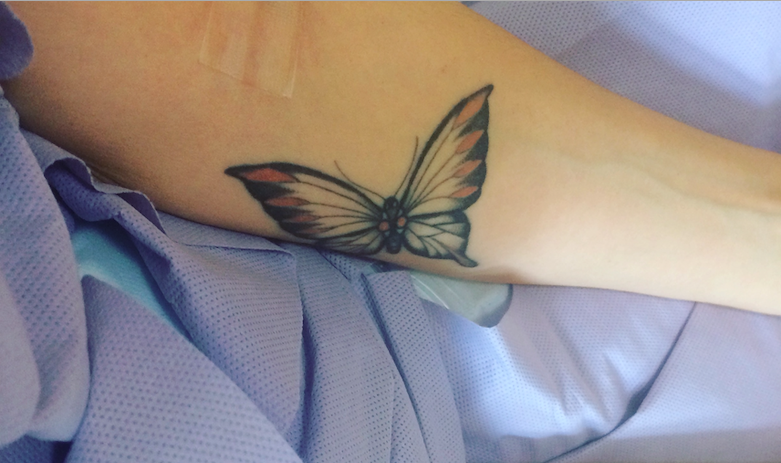An endometriosis body is something quite particular. It’s not that you can pick someone from a crowd, point at them, and just like Poirot, exclaim, “Aha! An endometriosis patient!” Yet, many of us share some physical traits. Whether it’s the dreaded “endo-belly,” adult acne, or a good batch of bruises due to blood loss and anemia, endometriosis adorns bodies with things most of the rest of the world doesn’t have to deal with.
Perhaps the most emotionally tricky bodily features are surgery scars. My scars made my body change in ways I wasn’t comfortable with. Trigger alert: I am speaking about belly buttons. Anyone have a phobia of these things? No? Just me? All right then. My first laparoscopy was performed by a nonspecialist who refused to remove any of my adhesions. They also left me with a crooked navel. How do I know it’s slightly slanted? Because my belly button jewelry now leans to one side. Yay!
The second laparoscopy didn’t fix my belly button but instead “modified” it even further. As a bonus gift, I got two extra scars on the lower part of my abdomen, one on each side, slightly reminiscent of Ed Sheeran’s “Divide” album cover.
It’s not that I strive for a pristine, untouched body of skin. I routinely add tattoos that alter the blank canvas my mother gave me. But scars feel different. They are imperfections I didn’t ask for. I can’t do much about them. I know they could also be bigger, but I’m not generally happy about their presence.
However, my scars are also a reminder of how lucky I’ve been.
Georgie Wileman has created a stunning photography project called #thisisendometriosis to encourage women worldwide to share their surgery scars. I spoke to Georgie recently and this is how she explained her project:
“Too often, people with endometriosis are subjected to repeat operations that usually cause further damage and pain. Excision surgery with an endometriosis specialist is currently the best treatment for this disease. This surgery isn’t covered by most insurance plans or healthcare systems internationally, this isn’t good enough.”
She is right. Excision surgery is still considered the gold standard for endometriosis treatment. While it doesn’t cure the disease, adhesions are less likely to return and symptoms are greatly reduced. In my case, it changed my life for the better.
I got my procedure through the free health system in the U.K. and had access to one of the best specialists in the country because of where I lived. Clearly, I am one of the lucky ones. For most patients with endometriosis, money plays a crucial role in what treatment they receive, forcing them to undergo a procedure that may not be the best for them, but is the one they can afford. This shouldn’t be the case.

What stands out quite visibly in Georgie’s project is the number of surgeries some patients have endured. I’ve only had two, but most have had many more than that.
This is the side of the disease that scares me. I wonder if by failing to find effective treatments for endometriosis, doctors are somewhat “butchering” patients. I admit this may be a strong way to qualify endometriosis treatment, but I feel like there’s too much cutting and so many invasive procedures performed in an attempt to simply “tame” the endometriosis beast, when what we really need is a cure.
As an endometriosis patient, I fear future scars.
I want doctors to leave my body alone, but I also want to stop the progression of my disease.
Our scars are complicated reminders. As I learn not only to accept, but also to love every inch of my body, I reflect on my luck. I also secretly wish for no more scars in my future. But if there are, I hope that they’re just another step on the way to a healthier existence.
***
Note: Endometriosis News is strictly a news and information website about the disease. It does not provide medical advice, diagnosis, or treatment. This content is not intended to be a substitute for professional medical advice, diagnosis, or treatment. Always seek the advice of your physician or other qualified health provider with any questions you may have regarding a medical condition. Never disregard professional medical advice or delay in seeking it because of something you have read on this website. The opinions expressed in this column are not those of Endometriosis News or its parent company, BioNews Services, and are intended to spark discussion about issues pertaining to endometriosis.


